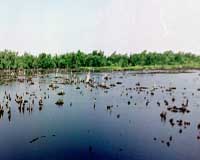| . |  |
. |
Moffett Field CA (SPX) May 06, 2010 A team of international researchers has brought the primary component of mammoth blood back to life using ancient DNA preserved in bones from Siberian specimens 25,000 to 43,000 years old. Studies of recreated mammoth haemoglobin, published Monday 3 May in Nature Genetics, reveal special evolutionary adaptations that allowed the mammoth to cool its extremities down in harsh Arctic conditions to minimise heat loss. "It has been remarkable to bring a complex protein from an extinct species, such as the mammoth, back to life," says Professor Alan Cooper, Director of the Australian Centre for Ancient DNA (ACAD) at the University of Adelaide, where the mammoth haemoglobin sequences were determined. "This is true palaeobiology, as we can study and measure how these animals functioned as if they were alive today." Professor Cooper is an Australian Research Council Future Fellow and a member of the University's Environment Institute. "We've managed to uncover physiological attributes of an animal that hasn't existed for thousands of years," says team leader Professor Kevin Campbell of the University of Manitoba, Canada. "Our approach opens the way to studying the biomolecular and physiological characteristics of extinct species, even for features that leave no trace in the fossil record." The project began over seven years ago when Professor Campbell contacted Professor Cooper, who was then based at the University of Oxford, to suggest resurrecting mammoth haemoglobin. "At the time, I thought 'what a great idea' - but it's never going to work," says Professor Cooper. "Still, bringing an extinct protein back to life is such an important concept, we've got to try it." The team converted the mammoth haemoglobin DNA sequences into RNA, and inserted them into modern-day E. coli bacteria, which then manufactured the authentic mammoth protein. "The resulting haemoglobin molecules are no different than 'going back in time' and taking a blood sample from a real mammoth," says Professor Campbell. The team used modern scientific physiological tests and chemical modelling to characterise the biochemical properties that confer mammoths with physiological cold tolerance. Team member Professor Roy Weber of the University of Aarhus, Denmark, who performed the physiological testing on the mammoth proteins, says the findings help show how the mammoth survived the extreme Arctic cold. "Three highly unusual changes in the protein sequence allowed the mammoth's blood to deliver oxygen to cells even at very low temperatures, something that indicates adaptation to the Arctic environment," Professor Weber says. "We can now apply similar approaches to other extinct species, such as Australian marsupials," says team member Dr Jeremy Austin, ACAD Deputy Director, who is currently using ancient DNA to study the evolution of the extinct thylacine and the endangered Tasmanian Devil.
Share This Article With Planet Earth
Related Links Adelaide University More detailed information of the study Darwin Today At TerraDaily.com
 US oil slick poses danger to springtime babies
US oil slick poses danger to springtime babiesNew Orleans, Louisiana (AFP) May 5, 2010 As spring blooms in the southern United States heralding the arrival of fledgling animal life, environmentalists are anxiously watching the spread of a giant oil slick off the coast. "The wildlife nursery of North America is at risk," warned Mark Floegel from Greenpeace USA. Particularly vulnerable are sea turtles and dolphins whose young could be the first to fall victim to the slick un ... read more |
|
| The content herein, unless otherwise known to be public domain, are Copyright 1995-2010 - SpaceDaily. AFP and UPI Wire Stories are copyright Agence France-Presse and United Press International. ESA Portal Reports are copyright European Space Agency. All NASA sourced material is public domain. Additional copyrights may apply in whole or part to other bona fide parties. Advertising does not imply endorsement,agreement or approval of any opinions, statements or information provided by SpaceDaily on any Web page published or hosted by SpaceDaily. Privacy Statement |